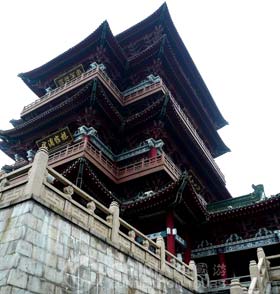
 Literally translated "Southern Prosperity", the capital city of Jiangxi province is a productive area, a part of the flat, fertile Gan Jiang River Basin that has been populated since the Han Dynasty (206 BC-220 AD). Anciently, Nanchang was most famous for its merchants, alchemists and tea. It was one of the key transit stations for porcelain, from the ancient town of Jingdezhen to the northeast, that so impressed the European world of the nineteenth century. The city remains an important farming area for grains, edible-oil, meat, milk, aquatic products (from the river and the nearby Poyang Lake) and vegetables.
Literally translated "Southern Prosperity", the capital city of Jiangxi province is a productive area, a part of the flat, fertile Gan Jiang River Basin that has been populated since the Han Dynasty (206 BC-220 AD). Anciently, Nanchang was most famous for its merchants, alchemists and tea. It was one of the key transit stations for porcelain, from the ancient town of Jingdezhen to the northeast, that so impressed the European world of the nineteenth century. The city remains an important farming area for grains, edible-oil, meat, milk, aquatic products (from the river and the nearby Poyang Lake) and vegetables.
It was the early twentieth century, however, that was to bring the city its present fame. The turbulent years of the Republic of China Period (1911-1950) were to come to a head for the emerging communist party in 1927, when Chiang Kaishek once again broke off from his "United Front" (against Japanese oppression). He purged Communists from the Nationalist Party and massacred suspected red members in a number of cities, including the Nanchang Commune in April, 1927.
Two members of the Nationalist army and renowned communists, Zhou Enlai and Zhu De, quartered in an old hotel, staged an uprising on August 1st, 1927 with a force of 30,000 (the first, fully organized People's Liberation Army), taking Nanchang after a five hour street battle. The troops lasted for three days until they were forced to flee, making their way to a remote mountain, Jinggangshan, to join a little known band of troops headed by a young Hunanese called Mao Zedong. The Jinggangshan base area, also known as the Jiangxi Soviet, is now a resort with some beautiful hiking possibilities.
The city itself is now mainly an area that is used by travelers as a transit point on the way to the more interesting areas of Jinggangshan, Lushan, and Jingdezhen. Although mostly just another large, concrete Chinese metropolis, Nanchang has a few charms, mainly in its night markets, back alleys and grotesquely appealing Soviet architecture. The population of around three and a half million is now mostly involved in continuing the city's role as the economic, political, scientific and technical center of Jiangxi.

